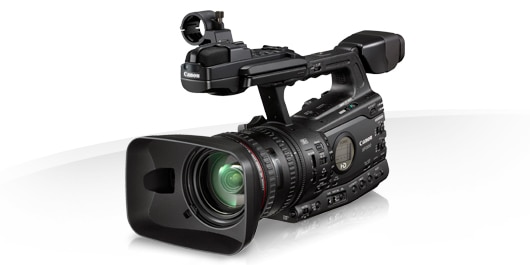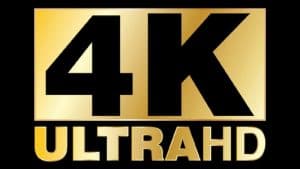Last Updated on June 4, 2020

Canon has long been touted as one of the pioneering leaders for advanced and innovative imaging and optical products. Their specialized and branded models for cameras, camcorders, lenses, and photocopiers have always dominated the industry of professional photographers and filmmakers.
So much so that these people would constantly vye for the next BIG Canon release, just as we are. If you’re looking to buy a new Canon camera this year, you might just choose one of these.
When we first heard of the additions to the Canon family, namely the Canon XF300 and Canon XF305, we were anticipating the moment we could get our hands on these babies and try them out ourselves.
We weren’t disappointed, not one bit.
- XF300 Camcorder with lens cap
- Lens Hood
- Eyecup
- Battery Pack BP-955
Canon XF300 & XF305 Review
Officially touted as a set of camcorder that’s finally designed to compete with other solid state recording devices from JVC, Sony, and Panasonic, we were surprised to find this gadget incredibly light, portable, and less expensive than its counterparts in the market. In fact, devices proclaimed as certified for broadcast use fall relatively inconvenient compared to the XF300 and XF305.
The fact that BBC is even using these camcorders for independent production means a great deal. This means that full programs and TV productions can be shot, sparing filmmakers and producers the hassle of small duration footage allowed by other camcorders.
Considering the competition, this is a major endorsement for the Canon brand. If BBC is setting an example for other major companies to use the camcorder, even private operators will seek their own XF300 or XF305.
In short, it’s not just a great gadget for filmmakers, but it’ll also give a range of individuals a run for their money, like art and photography enthusiasts, wildlife cinematographers, event video producers, wedding photographers, documentary shooters, etc.
To breakdown this major news, let’s start with the Canon XF300 review:
Weighing around 6.5 lbs with a solid and light body and easy-access buttons, this camera has a professional appearance without the bulk and hassle of large industrial camcorders. We also liked the fact that the Canon XF300 can go from being a run-and-gun shooting device to a shoulder-mount camera. The record buttons are conveniently placed where you’d expect it, giving the feeling that Canon spent years perfecting all the little inconveniences of wrongly-placed switches and knobs.
What’s more impressive is that the camera features a beautiful 4-inch LCD display which can freely rotate according to your shooting preferences. With regards to the resolution and recording mode, the bitrate format ranges from 50Mbps at 1920x1080, 35Mbps at 1920x1080 or 720x1080 and even until 25Mbps at 1440x1080. You can also tweak your record settings to shoot in 24p, 30p, 60p, and 60i.
But the most attractive quality of the XF300 is its 18x HD L-Series lens, which has a 29.3 wide-angle at F1.6 with separate rings for zoom, iris control, and focus.
Whats the Difference Between the Canon XF300 & XF305 ?
The difference between the Xf300 and Xf305 is whats called “the jack pack”. These are BNC connectors that will enable timecode and genlock synchronization.
Overall
Canon’s move to solid state video recording is proving to be an immense success. Although it’s not one of the companies that pioneered memory card-based camcorders, Sony and JVC started years ago, Canon’s dawdling seems to be a wise decision.
We found its XF300 ad XF305 highly convenient, extremely competitive in the market, and reasonably affordable. It’s just one of the many reasons you should own both of these too! So what are you waiting for? Buying these may just turn out to be the best decision you’ve made in your professional life!
Specification
Main Unit Specs
| Standard Definition or High Definition | High Definition |
| Power Supply (rated) | 7.4V DC (battery pack) |
| Video Recording system | Compression: MPEG-2 Long GOP Color Space: 4:2:2 (at 50Mbps recording) File Format: MXF Recording Modes: 50Mbps (CBR) 4:2:2, 1920x1080, (60i/30p/24p), 1280x720 (60p/30p/24p); 35Mbps (VBR) 4:2:0, 1920x1080 (60i/30p/24p), 1280x720 (60p/30p/24p); 25Mbps (CBR) 4:2:0, 1440x1080 (60i/30p/24p) |
| Audio Recording system | 2-Channel, PCM digital recording, 16-Bit; 48kHz |
| Image Sensor | (3) 1/3-inch CMOS |
| Total Pixels | Approx. 2.37 megapixels (2044 x 1160 pixels) each x 3 |
| Effective Pixels | Approx. 2.07 megapixels (1920 x 1080 pixels) |
| Maximum recording Time | 128GB Compact Flash (CF) card Greater capacity is possible when two cards are used. 25Mbps: 625 minutes 35Mbps: 445 minutes 50Mbps: 320 minutes |
| Lens | Canon 18x HD L Series Zoom, 4.1-73.8mm (35mm equivalent 29.3 – 527.4mm), f/1.6-2.8 |
| Focusing System | TVAF plus External Phase Difference Metering Sensor, Autofocus (Instant AF, Normal AF, Face AF), Manual, Full Manual |
| Max Shutter Speed | 1/2000 |
| Minimum Focusing Distance | 20mm (wide macro), 1m (entire zoom range) |
| White Balance | Auto, Manual, Custom (2000K – 15000K in 100K increments), Daylight, Tungsten |
| Frame Rate | 60i, 60p, 30p, 24p (50i, 50p and 25p optional upgrade available through Canon Factory Service Center) |
| Minimum Illumination | Full AUTO mode: 4.5 lux (Shutter speed 1/60, Gain +21dB); Manual mode: 08 lux (Shutter speed 1/4, Gain +33dB), (when 60i is selected) |
| Genlock Terminal | BNC (input only) |
| HD/SD-SDI Terminal | BNC (output only), with embedded audio |
| Timecode Terminals | BNC (input/output) |
| Image Stabilization | SuperRange Optical (Lens Shift) Modes: Standard, Powered, Dynamic, Off |
| Filter Diameter | 82mm |
| Viewfinder | 0.52-inch color widescreen, approx. 1,555,000 dots, approx. 100% field of view |
| LCD Screen | 4.0-inch color widescreen LCD, approx. 1,230,000 dots, approx. 100% field of view |
| Microphone | Stereo electrect condenser microphone |
| Recording Media | CF Card : 2 Slots, Movie files only SD Card: Still images, Custom Picture Data, Clip Metadata, Custom Settings |
| USB Terminal | Mini-B USB 2.0 Hi-Speed |
| Video Terminal | Component: Output only Composite: A/V terminal 3.5mm mini-jack, output only, BNC terminal, output only, signals can be output simultaneously through A/V terminal and BNC terminal |
| Audio Terminal | XLR 3-pin jack (2), Switchable between MIC/LINE |
| HDMI Terminal | Yes (Type A) |
| AV Mini Terminal/Headphone Terminal | 3.5mm stereo mini-jack |
| Operating Temperature range | 0 – 40? C, 32 – 104? F , 85% relative humidity |
| Dimensions | Approx. 6.0 x 9.3 x 15.0 in. (153 x 236 x 382mm) (not including lens hood, eyecup, grip belt) |
| Weight (not including lens hood and eyecup) | 5.9 lbs (2,670 g) (includes grip belt) |
| Weight | 6.6 lbs (2,980 g) (includes grip belt, lens hood, BP-955, CF Card (x1) and SD card/not including eyecup) |
XF300 Test Footage
Unboxing the XF300
Submit your review | |
I dont regret making the purchase of this camera one bit. The ergonomics and ease of use along with the HD video quality has made me a very happy customer. I would advise anyone who has the $$$ to get this. Paul
Buy the XF300 Now
Other Pages
Top Ten Professional Video Cameras



